This Special Report on Blockchain is available as PDF download below.
The still fledgling blockchain technology is just emerging out of the shadow of the digital currency bitcoin, guaranteeing as it does secure money transfer without the involvement of third parties such as banks. However, it is no longer only interesting for applications in the financial sector, but increasingly also for use within value chains, especially in cases where data security and data transparency are important.
Camelot Innovative Technologies Lab (Camelot ITLab), a specialist for digitalization of value chains, has been working with this technology for more than three years. Its Digital Experience2 now offers, for the first time, a service and product portfolio for identifying and implementing specific use cases in value chains.
The wider public first became aware of blockchain technology when it started to be used in connection with cryptocurrencies. At a first glance, bridging the gap to the management of value chains seems difficult, mainly because we’re talking about completely different applications and processes. After a more detailed analysis of the four cornerstones of the concept – decentralization, safeguarding of authenticity, immutability of the data and guaranteed consistency through reliable program sequences (smart contracts) – it quickly becomes clear that especially in the value chain there is a great deal of hidden potential for blockchain technology.
Removing the middleman through blockchain technology
At the latest when thinking of “trust machines”, which can be achieved through a combination of the four above-mentioned cornerstones and which in many scenarios eliminate costly and data-hungry middlemen, even the most technology-satiated value chain manager becomes alert. Global business networks present numerous problems which are deemed as solved, although they still require the involvement of trustees, clearing houses, legal advisors or other “trustworthy third parties”. These service providers exact a lot for their services, usually in the form of fees or unpopular data collections. In addition, the unavoidable manual intervention has the effect of making the processes increasingly slow and bureaucratic. These processes often involve complicated trade relationships between several parties between whom there is little or no trust.
In such situations, blockchain solutions promise a remedy through the decentralized installation of smart contract-based, distributed applications. They replace the aforementioned middlemen. Companies reap the benefits of optimization, streamlining and accelerated processes resulting from automation. Moreover, fraud and faulty procedures can be eliminated. Establishing these networks is intended to promote trust between the business partners. Responsibilities and obligations are clear and firmly embedded in the unmodifiable software network and operation is decentralized for all involved parties alike. While this may still sound like science fiction, in fact we’re already dealing with pending or current projects. It’s safe to assume that these solutions will in fact become reality in the course of the next two to five years.
Blockchain in supply chain management
Blockchain is attracting particular attention in supply chain management. As the many track and trace initiatives show, often the focus is only on individual blockchain features such as the immutability of the stored data. While the resulting solutions are often conceptually better than existing applications without blockchain, the full potential of the technology has not yet been exploited. Also, in the supply chain management environment there are use cases for blockchain-based “trust machines” and blockchain networks, although potential imbalances between the partners should be noted. It is a matter of finding out to whose benefit trust can be established here because the dominant players of a supply chain could control the use of the blockchain with clearly defined rules concerning membership and thus undermine the whole idea of blockchain being an equal and voluntary network. Many blockchain solutions for the value chain are still in their infancy, despite stabilization in the quality of the core blockchain technologies. There are still challenges to be met, such as the scalability of large volumes of data.
Yet today there are already a large number of applications ready for execution. As to why many solution providers still keep these under wraps, the answer is obvious: The gold in the “blockchain for business” area is no longer to be mined in the technology itself, but rather in the appropriate innovative use case, as exemplified by Bitcoin in the financial sector.
Use Case: sensor-driven Track & Trace ensures complete traceability
The sensor-driven Track & Trace solution developed by Camelot serves to monitor temperature-sensitive products such as medicines in order to guarantee the perfect condition of the products across the entire supply chain. To this end, the blockchain and IoT technologies are connected and a digital twin of the used sensor as well as the product are created in the blockchain. Using real-time monitoring, the condition of the delivered product is continuously written into the blockchain. As information can no longer be changed in the blockchain, a faithful and complete history of the product can be recorded across the entire supply chain. Decentralized storage of the blockchain prevents falsification. Using the information that has been verified through blockchain technology, the recipients of the goods, whether manufacturer or final customer, can easily check whether their product still retains its original characteristics, has been correctly transported and is fit for purpose in accordance with the contract, thus ensuring a high level of trust between the parties.
What is blockchain?
When we speak of blockchain, we’re referring to a technology possessing disruptive features. Blockchain is a concatenated list in which every list entry (block) can comprise one or more data sets. The concatenation is realized by means of cryptographic hash entries, a kind of checksum. Each hash entry is created out of all data sets of a list entry and included in both the previous and the subsequent list entry. Consequently, list entries are unalterably linked together, like a chain.
Furthermore, blockchain is a fully redundant data repository. All participants in a network possess all data, which is constantly synchronized. However, the true quintessence is the programmability of the network via smart contracts. A smart contract is a small program that is installed in the blockchain and kept there – just like other data – in a redundant, unalterable manner. Through the interplay of smart contracts, data and predefined events certain processes can be modeled in a counterfeit-proof and trustworthy way without the need for the middlemen that have been necessary before now.




















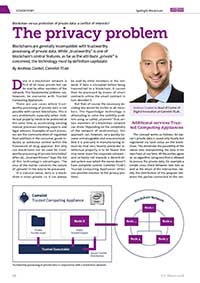



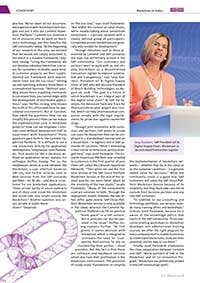

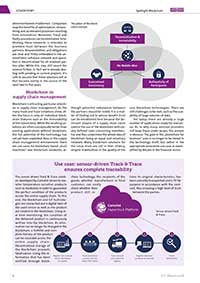
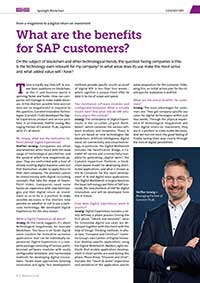
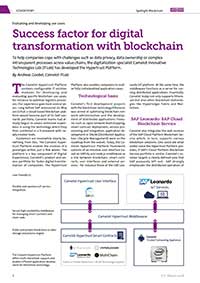




Add Comment